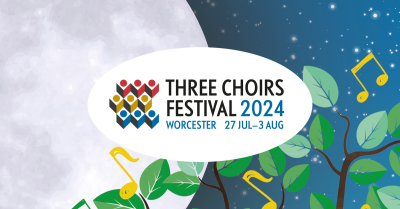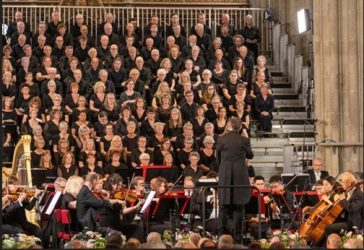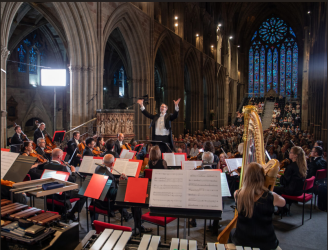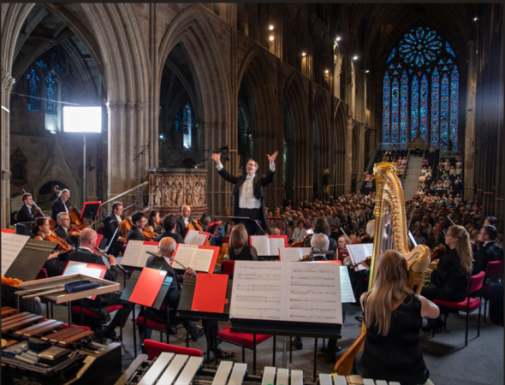
 United Kingdom Three Choirs Festival [3] – Biles-Liddell, Weir, Elgar, Snider: Three Choirs Festival Chorus, Philharmonia Orchestra / Samuel Hudson (conductor). Worcester Cathedral, 29.7.2024. (JQ)
United Kingdom Three Choirs Festival [3] – Biles-Liddell, Weir, Elgar, Snider: Three Choirs Festival Chorus, Philharmonia Orchestra / Samuel Hudson (conductor). Worcester Cathedral, 29.7.2024. (JQ)

Cameron Biles-Liddell – Yr Afon Yn Yr Awyr (2022)
Judith Weir – O Sweet Spontaneous Earth (2021)
Elgar – Serenade for Strings, Op.20 (1892)
Sarah Kirkland Snider Mass for the Endangered (2018)
This Three Choirs Festival concert offered an eclectic range of pieces. With the exception of the Elgar Serenade, I had never heard any of the works concerned, so I took my seat in Worcester Cathedral with a sense of anticipation.
Samual Hudson began with a short work (about 12 minutes) for orchestra by the young Welsh composer, Cameron Biles-Liddell. He is based in North Wales and I learned from his website that his music ‘draws significantly from the natural landscapes, aspects of momentum, as well as conveying his own Welsh heritage and folklore through music’. The work we heard, Yr Afon Yn Yr Awyr (The River in the Sky) was premiered in Wales in November 2022 and was receiving its first performance in England. The composer describes the work as ‘a suite of three interrelated movements inspired by the nickname given to the aqueduct based in Pontcysyllte, North Wales. In essence, I wanted to explore how I could musically create a sense of floating through stasis and motion, much like the water in the aqueduct flowing above the River Dee. As such, each movement flows directly into the next, exploring a particular aspect of the imagery of a River in The Sky. What connects the individual movements is the melodic line that subtly weaves it way through different contexts and moods representing how the river in flows from Pontcysyllte through North Wales and beyond’. Yr Afon Yn Yr Awyr is scored for quite modest forces comprising single woodwind, horn, trumpet, trombone, percussion (1 player), harp and strings.
I really warmed to this piece. In the first of the three movements the music is lively and energetic. Under Hudson’s direction, the Philharmonia played it with crisp attack. There is a lot going on in this music – dare I risk a watery pun by saying both on and under the surface? However, this activity, and in particular the rhythmic vitality, is never just for its own sake. Seamlessly, Biles-Liddell moved into the central slow movement, which is the heart of the work. The music is slow and somewhat mysterious in nature. I must have been in punning mood because I scribbled in my notes ‘still waters run deep’. I thought this was very imaginative and evocative music. It achieved a brief, powerful climax, but for the most part the mood was tranquil. Fittingly for a Welsh composer, Biles-Liddell deployed the harp prominently and to evocative effect as the movement neared its close. The final movement evoked again the daytime energy of the river. As the piece moved towards its conclusion the music became dynamic and fast; the river was in full spate. Yr Afon Yn Yr Awyr is a confident, attractive and inventive score which Hudson and the Philharmonia played very well indeed. I enjoyed it very much and to judge from the warm reception given to the composer, who was present, so did the rest of the audience.
Also present was Dame Judith Weir, whose 70th birthday is being marked by the Festival this week with the performance of several works. Tonight, we heard a fairly recent piece for chorus and string orchestra, O Sweet Spontaneous Earth. In this work, which plays for about 15 minutes, Weir set three poems by American poets; each poem, she says, ‘is about the Earth, and our experience of living on it’. I have admired many of Weir’s pieces in the past but I struggled somewhat with this one. I think partly this was because the work opens with a setting of a poem O sweet spontaneous by E. E. Cummings (1894-1962). I have never been able to understand Cummings’s poetry – the fault is mine, I’m sure – and so I find it hard to appreciate musical settings of his verse. Weir says that the poem ‘talks about the Earth’s persevering efforts to regenerate itself despite the depredations of its inhabitants’; I have to say that wasn’t obvious to me from reading it. Weir’s setting of the poem is purposeful and was strongly projected by the Festival Chorus. The longest movement is a setting of Peace on Earth by William Carlos Williams (1883-1963); this ‘speaks of the magnificent constellations of stars shining in the sky above us while we sleep peacefully’. There was warmth in the music for the choir; their singing of each stanza was punctuated by interesting orchestral interludes. Finally, came I reason, Earth is short by Emily Dickinson (1830-1886). In this poem of three stanzas, Dickinson ‘ponders the short time we actually spend on Earth, and what happens afterwards’. Weir set these words as a kind of chorale which grew in power as the movement unfolded until, by the third stanza, the tone was genuinely uplifting. Other works by Weir have stirred me more in the past than O Sweet Spontaneous Earth. However, her piece received a committed, very good performance from the Festival Chorus.

We were on much more familiar territory with Elgar’s Serenade for Strings. The piece was played by a modest-sized string orchestra (6/6/4/3/2, I think) and the size of the ensemble produced huge benefits in terms of clarity. The first movement, ideally paced by Hudson, flowed really well; there was a delightful spring in the rhythms. The final movement, too, was stylish and extrovert. It is the central slow movement, though, which lies at the heart of the Serenade. The performance was beautiful; the playing had warmth and affection. This may be a fairly early work, dating from several years before the mastery of ‘Enigma’ and Gerontius, but this is quintessential Elgar. It was testament to the distinction of this performance that during it you could have heard a pin drop. This was an outstanding performance of the Serenade; indeed, it was the finest performance of anything that I have heard so far this week.
After the interval came the signature work of the evening, one that was presumably chosen because its concept and design fitted with one of the main themes of this year’s Festival; in the words of Artistic Director Samuel Hudson, ‘the natural world, at a time when the challenge of preserving and protecting our planet is relevant to us all’. We heard the UK premiere of Mass for the Endangered by the American composer, Sarah Kirkland Snider (b.1973). In this work, Snider combined the text of the Latin Mass with poetry by her fellow American, Nathaniel Bellows who is a writer, visual artist, and musician. Kirkland described Bellows’ words as ‘original’; I am not sure if that means they were written specifically for this project but that may well be the case. The composer said this about her work: ‘Mass for the Endangered embodies a prayer for endangered animals and the imperiled [sic] environments in which they live… [it] appeals for parity, compassion, and protection, from a mindset — a malignance or apathy — that threatens to destroy the planet we all are meant to share.
This is a substantial work and lasted some 50 minutes. It was conceived for SATB chorus and twelve instruments, comprising single strings, four woodwinds, percussion (1 player), piano and harp. For this performance, however, the string section had been increased – I think the same number of players took part as in the Elgar – though I couldn’t be sure if the woodwind section had been expanded; I think not. This expansion of the instrumental forces followed the precedent set with Josph Fort’s reduced scoring of Holst’s The Cloud Messenger (review here) and I suspect it was done for the same pragmatic reasons. However, on this occasion I am not sure that the idea worked as successfully.
Snider begins with a Kyrie which combines ‘Kyrie eleison’ with words by Bellows. The music opens quietly but it is not long before there is increasing urgency. Here, and elsewhere in the piece, I couldn’t always discern the words clearly, even though my seat was quite near the front; since clarity of diction isn’t usually an issue with the Festival Chorus, this may be a question of the nature of Snider’s vocal writing. I jotted down the words ‘music of contrition’ in my notes. This was a powerful opening to Mass for the Endangered. The end was particularly effective; the sopranos held a note for an awfully long time while the orchestral accompaniment gradually faded into quiet fragments. In the Gloria there are no contemporary words; Snider sets only the traditional Latin text. Her approach to the Gloria is most unusual and original. Her music is not a conventional hymn of praise; instead, the setting opens with an extended, quiet passage for sopranos (eventually joined by the altos, I think), accompanied just by the harp. The harp part is fiercely independent of the vocal line and, in truth, seems to offer no help to the singers (that is just a statement of fact, not a criticism). The vocal lines are long and carolling. It seemed to me that here Snider conveys not so much praise as a sense of wonder. Eventually, the full choir is deployed, and the rest of the orchestra, but their involvement is fairly brief; Snider then returns to the female voices and harp to end the Gloria quietly. This is a most interesting and original movement
The third movement. ‘Alleluia’ sets words by Bellows. Male voices are prominent in this movement, singing against orchestral writing that is rather jagged in nature. I found it hard to discern the words, perhaps because the men were positioned at the rear of the choir. To be honest, I didn’t enjoy this movement very much. If the Gloria used no contemporary words, almost the reverse is true in the Credo. Here, almost all the text is provided by Bellows, though a fragment of the Credo text (sometimes in Latin, sometimes in English) appears from time to time. This fragment was, I think, schematically important because it was based on the words ‘Et expecto’. I fear that this movement was the point in the work where I parted company with Snider. It is an extensive movement, setting a substantial text by Bellows. His words, to be frank, are a litany of environmental and social justice aspirations. I don’t think anyone would seriously argue with the ideas expressed by Bellows; I certainly wouldn’t. The problem is that there are far too many points made in the text and Snider sets the words to loud, emphatic music; that is understandable, as she surely wanted to emphasise the importance of the sentiments. However, well before the movement’s end I felt I had been hit over the head; this was surely a case where less would have meant much more. This was also the point when I felt that the decision to expand Snider’s scoring was misjudged. In the Holst piece the previous night it worked well because Holst’s scoring is so often delicate. By contrast, Snider’s instrumental writing – for the strings in particular – is much stronger in profile (again, a statement of fact, not a criticism) and the orchestra rather overwhelmed the singers at times, though the Festival Chorus offered energised, strongly committed singing.
In the Sanctus/Benedictus movement, Snider set only the words from the Mass. There was much joyful-sounding writing for the choir and the music generally had a lighter touch, which was a welcome contrast after the Credo. In the Benedictus in particular there were a number of short solo passages, taken by members of the Festival Chorus. The individual singers were valiant though it seemed to me that the writing often put them under strain. A solo voice – a lovely soprano line, very well sung – was heard at the start of the final movement, the Agnus Dei. Here, much of the text was by Bellows and Snider set his words to music that grew in intensity, though there were also lyrical passages; the alternation between lyricism and intensity worked well. Snider brought the work to a close in a mood of uneasy quiet, reflecting the apprehension we must all feel for the state of our world and its future.
I really wanted to like Mass for the Endangered not least because it addresses very important issues. It includes some good and persuasive passages. However, I felt that there was quite a degree of overkill at times in the contemporary text and the way that Snider set those words. The style of the music came as a bit of a surprise. Snider’s biography includes press quotes about her music describing it as ‘rapturous’ and ‘ravishingly beautiful’. There was little of that apparent to me in Mass for the Endangered though I readily acknowledge that I was hearing it for the very first time. The music struck me as much grittier than those press quotes suggested; perhaps, though, that reflects the seriousness and urgency with which Snider views the issues that are confronted in her Mass.
The quality of the performance seemed to me to be high; Hudson clearly believes in the score and conducted it urgently. The audience responded generously to the performance. I am sure it’s an important score but it didn’t move me as I had hoped it would. There is a recording of the work on the Nonesuch label, which I have not heard; it’s by the ensemble Gallicantus conducted by Gabriel Crouch. I suspect that uses the composer’s original scoring; perhaps I should give Mass for the Endangered another try.
John Quinn
